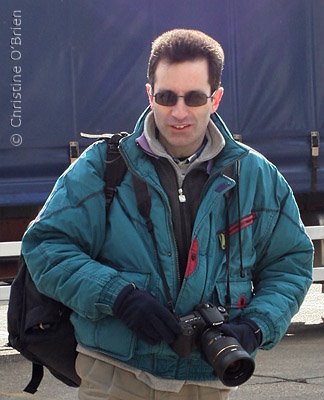Travelling light (part 2) - choosing a device

As I mentioned in part one of this piece, I now take two downloaders with me when I am travelling with the intention of taking photos and the same images are written to both of them. One device is a "SmartDisk FlashTrax XT" with 80 GB of capacity.
The plus points for this device are as follows (from my personal point of view): Clamshell design keeps the screen protected when closed in the same way as a laptop computer - very useful when on the move. Very long battery life. Ability to read a wide range of RAW files. High storage capacity for the price (and it is possible that an even bigger drive could be substituted at a later date although doing so would void the warranty).
The weak points compared to some similar devices are: Somewhat poor quality screen image compared to some competitors - fine for checking images, but not so good for assessing their exposure or appreciating them aesthetically. Somewhat dated design. Not quite as compact as some others.
I also take a "Digital Camera Partner" as my backup device. In spite of the rather "chummy" name, this is a simple and somewhat minimalist gadget, which does not allow viewing. In fact it has no screen at all, but communicates it's status by means of a row of coloured lights. It does have one great advantage, and that is that it can be purchased without a hard drive. Of course it is no use without a drive, but the fact that it is "user installable" indicates that drives can be changed round easily. This gives it almost unlimited storage capacity, as all you have to do is take a number of laptop hard drives and swap them out as each is filled. Very flexible. It also means that you can buy your own hard drive (or take it out of a dead laptop), which may help to keep costs down. There are many similar products around, particularly on eBay.
So what are the alternatives? There are many, but I will concentrate on ones with colour screens (the more expensive ones) as they have more features that need explaining. The first one (in fact four) to consider is the Epson series of devices. The original one was called the P2000. It is still on the market and comes with a 40 GB drive and a truly superb screen. Epson introduced the P4000 with an 80 GB drive some time ago. To coincide with Photokina 2006 Epson introduced the P3000 and P5000. Still 40 GB and 80 GB capacity, the most noticeable difference is a slightly bigger screen and an increase in display quality (did it really need it?). The screen remains relatively unprotected in transit (it comes with a soft case) and I know of one P2000 that ended its life when something fell and damaged the screen.
The next on the list is probably the "Jobo Giga Vu Pro Evolution" - nice device, long name. Available in capacities of 40 GB, 80 GB and 120 GB. I haven't seen one, but reports suggest that the display on this is in a similar league to the Epson P2000/P4000. Although not a clamshell design, it comes with a clip-on hard plastic lid to protect the screen. Jobo also produce the "Giga One" which is a much simpler device, with status screen only.
Vosonic produce a bewildering range of suitable but varied devices. The one that has recently attracted my attention is the VP8360. It looks to have a good-sized screen. It is available in capacities of 60 GB, 80 GB and 100 GB, but I have seen it advertised through one outlet without a drive, indicating that it may be another device to offer easy hard drive swapping (see my updated comments). I am keen to get my hands on one of these to see the screen quality for myself, and when I do I will likely put a mention here.
Another announcement timed to coincide with Photokina was that of the Canon Media Storage M30 and M80 (have a guess at the capacities of these two devices). These look set to compete head on with Epson. One bonus for owners of Canon cameras such as the EOS 5D, 20D and 30D is the fact that these downloaders use the same battery.
There are lots of other products on the market, but I will mention only one. It could be that you already have one of these. The latest (full size) iPod comes in capacities of 30 GB and 80 GB. It has a rather nice screen, although it is not as big as the best of the dedicated downloaders. With the addition of a small adaptor (iPod Camera Connector) you can connect an iPod to your camera using the camera's USB cable. Not only are they very compact, but if you have one already then this would be the cheapest option of all.
Finally it is worth mentioning that almost all of these products have additional functions. Most play music and video, so can be used to watch films. Some (the FlashTrax is an example) pick up FM radio too. They can also be used as additional storage for your computer.
The image above was taken in the grounds of the Alhambra Palace in Granada, Spain, September 2006

0 Comments:
Post a Comment
<< Home